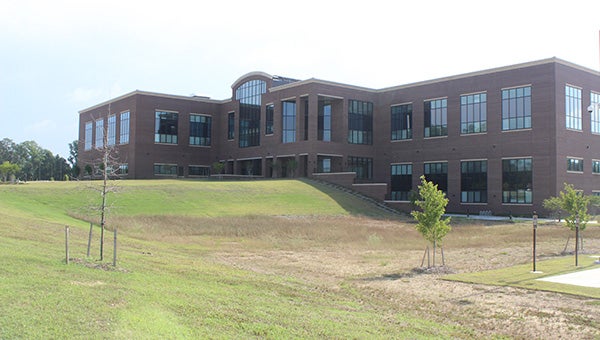New building puts ERDC key managers all under one roof
Published 4:37 pm Sunday, June 24, 2018

- New administration building at ERDC. (John Surratt/The Vicksburg Post)
All of the U.S. Army Engineer Research and Development Center’s key administrators are now housed under one roof.
In March, 263 people began moving into ERDC’s new $51 million, 142,000-square-foot headquarters building in the center of the facility’s campus.
Three months later, 12 different divisions, including ERDC’s major command staff division and executive offices are under the same roof for the first time in the organization’s history.
“Most of those offices were in other buildings,” said Mike Channell, director of ERDC’s installation and support division. “It (the new building) consolidated ERDC command into one single building.”
It also includes the offices of health services, safety, security, equal employment opportunity, contracting, internal review, the director of public works, public affairs and resource management, and the office of counsel.
Before the building was completed, Channell said, “We were scattered all over the 700 acres here. We were just in other buildings; just occupied wherever we could find space.”
Jack Wheeldon, ERDC’s master planner, called the building a “one stop shop. When you come to ERDC, whether you’re a visiting dignitary or anyone else, you come to this focal point and this whole function of this building is to support our labs. We have four labs on station and we have three more geographically separated, and this focal point takes care of all of them.”
The labs, Channell said, were the reason the headquarters building was located at the center of the ERDC campus.
“The environmental lab, the geotechnical lab, even the coastal hydraulics lab, are in walking distance,” he said, adding only the information technology lab has to be reached by a vehicle. “It puts us closer to the (IT) lab. They do a lot of business with us, especially their management, so it’s a lot easier access to everybody.”
Besides access, the building has a 500-seat auditorium, a 100-seat conference room, a 50-seat video/teleconferencing room, a 6,350-square-foot archival library, a 6,100 square-foot atrium and 4,500 square feet of classroom space.
“We can bring a lot of people together,” Channell said. “Up until the auditorium was built, a lot of people used the auditorium in Building 1006, which was the original building here on station. It could only house half as much, maybe 200 people.”
Now, he said, officials can get an entire lab “plus some more people,” in the auditorium.
Because of the building’s ability to provide digital access, Wheeldon said, officials can use the conference rooms and classrooms to accommodate more people meetings and conferences, “And pump the information to here and the offsite locations.”
The building’s six classrooms, Channell said, belong to the West Graduate Institute, which allows employees to pursue graduate degrees from other universities.
“This facility has already hosted several events,” Wheeldon said. “We hosted all the district commanders and the division commanders across the continental U.S.”
Having the auditorium and other available rooms and building’s atrium for conferences, he said, has reduced the cost of providing facilities.
The library, Channell said, takes up most of one floor of the building. It has 12,000 linear feet of bookshelf space.
Librarian Joy Brooks said the library’s collection includes a total of 300,000 items in digital and printed material, and was named the government’s 2017 library/information center of the year. “We beat out NASA,” she said.
The collection, she said, contains every map developed at ERDC going back to its founding as the Waterways Experiment Station in 1929.
In the old building that housed the library, she said, the collections were on two floors. “Space was very tight. Here, we’ve got plenty of room.”
Besides the auditorium, classrooms and conference rooms, the building boasts a cafeteria capable of accommodating 150 people with a separate meeting room for programs.
“It’s just a much bigger place,” cafeteria manager Peggy Jones said. “Everything’s better.”
Employees for Birmingham, Ala.-based Yates Construction Co. began work on the headquarters building in April 2015, and a groundbreaking ceremony was held that August. Representatives from the Corps of Engineers Mobile District oversaw the project.
And while the building was declared complete in March, Channell and Wheeldon said there are still some minor issues that need taking care of.
Channell said the old headquarters building is now being used as a multipurpose building and as temporary office space.
“Our labs are in need of office space,” he said. “With the workload increasing and hiring of new people, we don’t really have office space for a lot of our people.
“It’s a perfectly good building, so we want to use it for helping our labs.”
Wheeldon said the new headquarters building “is not a simple administrative building,” pointing out the diversity and features and facilities it houses.
And there are plans to make the building even more unique.
Channell said the reason for building the headquarters on its site was to make it the focal point for ERDC, and create a place where researchers from the labs could come and meet and collaborate on projects. He said the lab researchers are taking advantage of the building.
Wheeldon calls it “collaborative space,” where people have facilities to connect their laptop computers to the building’s wifi system and work together. “You can walk around anywhere (in the building) and you’re connected with a preapproved computer,” he said.
Channell said the building is getting close to meeting its expectations.
“For what we initially set out to do, there’s so much more we want to do,” Channell said.
“We’ll stay constantly updated (on equipment). We will be constantly looking at the technology and stay up with the technology.”






